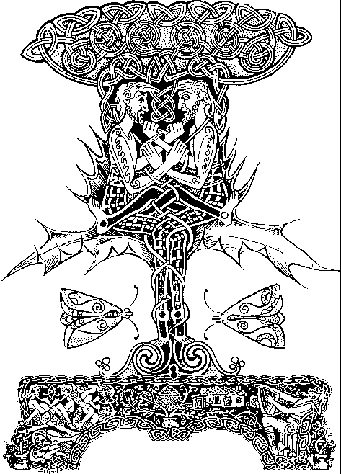
BARDIC PERSPECTIVE

Ultimately, when you are studying one of the priesthoods, you will notice that they each are individual ways of describing the interactions of the elements making up the Universe. Each one is a perspective.
This is why we recommend the student priest focus on the pattern of the thing, rather than technique. By focusing on the pattern, not only do you learn individual techniques at an accelerated rate by seeing the bigger picture, you can also overlay this understanding onto apparently unrelated issues.
Although I use all three, the Bardic perspective is one I find exceptionally useful. As an example of its use, in delineating social and political interactions (very Druidic) and calendars, I use music and rhythm to help me organize the data.
In relationship to Vatis craft, while eating in a local restaurant, I became very aware of the complex physical rhythm that my body had entered into in response to the popular "new country" music being piped into the dining hall. I am not a big Country fan, but the distinctive hips, pelvis, leg and upper body swaying induced by the music had an extremely pleasing and balancing effect on several nerve systems of the body. This would be particularly true if the exposure to the physical stimulus was extended and unconscious. Each distinctive musical rhythm effects a different system of the body. Therefore, its use in healing is evident.

In relationship to Bardic priesthood elements, music and rhythm are obvious components, but the others use the same tools. In the course of my secular work, I write scripts for educational and children's television. My greatest asset in this has been the discovery of a meter/rhythm inherent in "successful" satisfying television viewing which I've translated into melodic sequences. It enables me to predict and predicate emotional responses to the visual and audio impulses I can delineate in real time.
In visual and studio arts and crafts the effect of the meter is less obvious but absolutely necessary. When I paint or draw I know that there is a particular curve or proportional pattern to differing attitudes in a composition. I feel the right line and arrangement. It is well-known that visual art is not an objective duplication of the subject. It's a symbolic representation that communicates the vision of the artist through symbolic imaging in light and color. But its rhythm, metered periodicity was made crystal clear when one uses digital, technological art tools, like computers. A visual art work is a melody or dance in light waves as they interact with the eye and body cycles.
History, too, is defined by he periodic repetition of human social and political behavior. The common thread all of these have had is the core of the Bardic Perspective:
TIMING AND PERIODIC OR WAVEFORM REPETITION.
The Poetry Corner
|
When I am old When I am old When I am old eyes and hands wandering in a forest of illusion A man Not knowing Behind clouds Possible futures The earth calling to him His soul quickens
The Journey Born.. . . Descendant . . . Gwydion shows me I am seen and cared for, Forged . . .
| all is silence Walls of glass With love Winter ends Faded memories An ancient sadness Gwion de Wyder
Through great agreement | The test began. Such joy! Such sorrow! Challenge given. Wisdom gained. Childhood passes . . . Amergin is Awake! Gwyliedydd 1997 My world is naught, Your grip is strong . . . Pulling, ever pulling, me to you. We play the game . . . Few for me . . . Sight is fading, fading fast. Torment continues . . .  Drawn, As the moth to the flame, Caring not if I'm consumed. Driven. After all, Isn't that my aim? Ripped apart, for all to see. Kneeling before you . . . My heart is ripped, Gwyliedydd 1997 |

 |